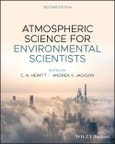Enlightens readers on the realities of global atmospheric change, including global warming and poor air quality
Climate change and air pollution are two of the most pressing issues facing Mankind. This book gives undergraduate and graduate students, researchers and professionals working in the science and policy of pollution, climate change and air quality a broad and up-to-date account of the processes that occur in the atmosphere, how these are changing as Man’s relentless use of natural resources continues, and what effects these changes are having on the Earth’s climate and the quality of the air we breathe.
Written by an international team of experts, Atmospheric Science for Environmental Scientists, 2nd Edition provides an excellent overview of our current understanding of the state of the Earth’s atmosphere and how it is changing. The first half of the book covers: the climate of the Earth; chemical evolution of the atmosphere; atmospheric energy and the structure of the atmosphere; biogeochemical cycles; and tropospheric chemistry and air pollution. The second half looks at cloud formation and chemistry; particulate matter in the atmosphere; stratospheric chemistry and ozone depletion; boundary layer meteorology and atmospheric dispersion; urban air pollution; and global warming and climate change science.
- Provides succinct but detailed information on all the important aspects of atmospheric science for students
- Offers the most up-to-date treatment of key issues such as stratospheric chemistry, urban air pollution, and climate change
- Each chapter includes basic concepts, end-of-section questions, and more in-depth material
- Features contributions from the best experts and educators in the field of atmospheric science
Atmospheric Science for Environmental Scientists, 2nd Edition is an invaluable resource for students, teachers, and professionals involved in environmental science. It will also appeal to those interested in learning how the atmosphere works, how humankind is changing its composition, and what effects these changes are leading to.
Table of Contents
List of Contributors ix
Preface xi
Abbreviations, Constants, and Nomenclature xiii
1 The Climate of the Earth 1
John Lockwood
1.1 Basic Climatology 1
1.2 General Atmospheric Circulation 3
1.3 Palaeoclimates 6
1.4 Polar Climates 12
1.5 Temperate Latitude Climates 16
1.6 Tropical Climates 20
Questions 28
References 28
Further Reading 30
2 Chemical Evolution of the Atmosphere 31
Richard Wayne
2.1 Creation of the Planets and Their Earliest Atmospheres 34
2.2 Earth’s Atmosphere before Life Began 37
2.3 Comparison of Venus, Earth, and Mars 38
2.4 Life and Earth’s Atmosphere 41
2.5 Carbon Dioxide in Earth’s Atmosphere 47
2.6 The Rise of Oxygen Concentrations 50
2.7 Protection of Life from Ultraviolet Radiation 60
2.8 The Great Oxidation Event and Related Issues 64
2.9 The Future 68
Questions 68
References 69
Further Reading 74
3 Atmospheric Energy and the Structure of the Atmosphere 75
Hugh Coe
3.1 The Vertical Structure of Earth’s Atmosphere 75
3.2 Solar and Terrestrial Radiation 77
3.3 Solar Radiation, Ozone, and the Stratospheric Temperature Profile 82
3.4 Trapping of Longwave Radiation 85
3.5 A Simple Model of Radiation Transfer 85
3.6 Light Scattering 90
3.7 Conduction, Convection, and Sensible and Latent Heat 96
3.8 Energy Budget for Earth’s Atmosphere 103
3.9 Aerosols, Clouds, and Climate 106
3.10 Solar Radiation and the Biosphere 109
3.11 Summary 111
Questions 112
References 112
Further Reading 114
4 Biogeochemical Cycles 115
Dudley Shallcross and Anwar Khan
4.1 Sources 119
4.2 Sinks 119
4.3 Carbon 124
4.4 Nitrogen 132
4.5 Sulphur 134
4.6 Halogens 142
4.7 Hydrogen 152
4.8 Summary 153
Questions 153
References 154
Further Reading 157
5 Tropospheric Chemistry and Air Pollution 159
Paul Monks and Joshua Vande Hey
5.1 Sources of Trace Gases in the Atmosphere 159
5.2 Key Processes in Tropospheric Chemistry 164
5.3 Initiation of Photochemistry by Light 165
5.4 Tropospheric Oxidation Chemistry 166
5.5 Night-Time Oxidation Chemistry 178
5.6 Halogen Chemistry 182
5.7 Air Pollution and Urban Chemistry 187
5.8 Summary 195
Questions 197
References 199
Further Reading 202
6 Cloud Formation and Chemistry 203
Peter Brimblecombe
6.1 Clouds 203
6.2 Cloud Formation 204
6.3 Particle Size and Water Content 207
6.4 Dissolved Solids in Cloud Water and Rainfall 209
6.5 Dissolution of Gases 211
6.6 Reactions and Photochemistry 219
6.7 Radical and Photochemical Reactions 224
6.8 Summary 227
References 228
Further Reading 231
Websites 231
7 Particulate Matter in the Atmosphere 233
Paul I. Williams
7.1 Aerosol Properties 235
7.2 Aerosol Sources 245
7.3 The Role of Atmospheric Particles 254
7.4 Aerosol Measurements 262
7.5 Summary 265
Acknowledgement 266
Questions 266
References 267
8 Stratospheric Chemistry and Ozone Depletion 271
Martyn P. Chipperfield and A. Rob MacKenzie
8.1 Ozone Column Amounts 272
8.2 Physical Structure of the Stratosphere 275
8.3 Gas-Phase Chemistry of the Stratosphere 282
8.4 Aerosols and Clouds in the Stratosphere 287
8.5 Heterogeneous Chemistry of the Stratosphere 290
8.6 Future Perturbations to the Stratosphere 291
8.7 Summary 295
Questions 295
References 296
9 Boundary Layer Meteorology and Atmospheric Dispersion 299
Janet Barlow and Natalie Theeuwes
9.1 The Atmospheric Boundary Layer 299
9.2 Flow over Vegetation 307
9.3 The Urban Boundary Layer 312
9.4 Dispersion of Pollutants 319
9.5 Summary 326
Questions 327
References 327
Further Reading 329
10 Urban Air Pollution 331
Zongbo Shi
10.1 Introduction 331
10.2 Urban Air Pollution - A Brief History 331
10.3 Scale of Urban Air Pollution 333
10.4 Air Pollutants and Their Sources in the Urban Atmosphere 334
10.5 From Emissions to Airborne Concentrations 339
10.6 Urban-Scale Impacts 343
10.7 Means of Mitigation 349
10.8 Summary 361
Acknowledgement 363
Questions 363
References 364
Further Reading 365
11 Global Warming and Climate Change Science 367
Atul Jain, Xiaoming Xu, and Nick Hewitt
11.1 Historical Evidence of the Impact of Human Activities on Climate 369
11.2 Future Outlook of Climate Change 379
11.3 The Integrated Science Assessment Modelling (ISAM) 386
11.4 Potential Impacts of Climate Change 393
11.5 Summary 395
Acknowledgement 396
Questions 396
References 396
Appendix: Suggested Web Resources 399
Index 401








